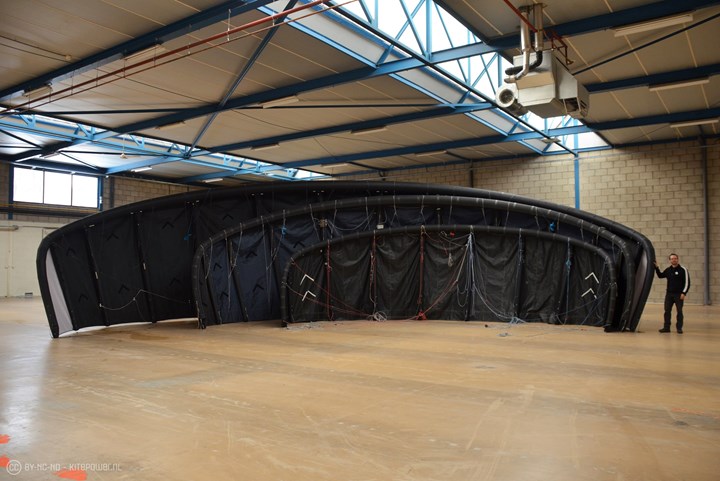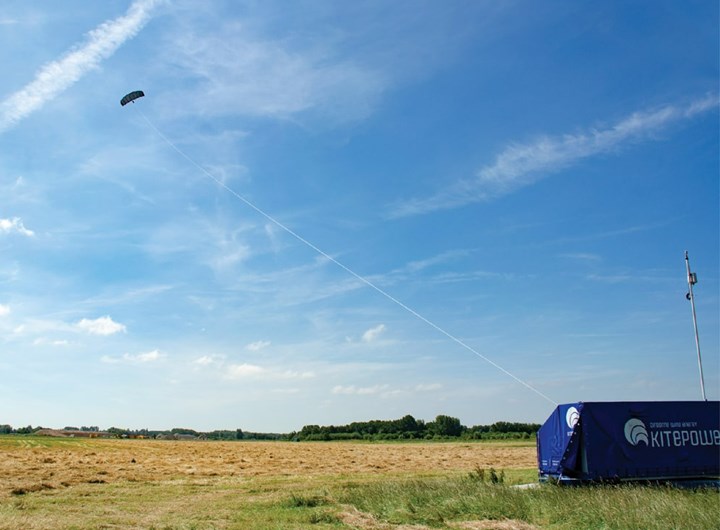
Photo Credit, all images: Kitepower
Founded by researchers at Delft University of Technology (TU Delft, Netherlands), startup company is working toward development and deployment of a kite-based, airborne wind energy (AWE) system, designed to be a mobile, low-footprint renewable energy solution.
The researchers’ first 20-kilowatt (kW) proof of concept was demonstrated in 2007, and the company was officially co-founded by researchers Johannes Peschel and Roland Schmehl in 2016. This year, Kitepower raised well over its €700,000 target in a recent crowdfunding campaign aiming to commercialize the company’s Falcon model. Falcon is a 100-kW AWE system said to be able to generate 450 megawatt-hours (MWh) of electricity per year, enough to power 150 homes.
Kitepower’s patented technology, in development at TU Delft since the 1990s, features an airborne kite and control unit that are tethered to a fixed ground station, which converts the mechanical energy of the kite into electrical power. The control unit controls the trajectory of the kite in the air — the kite is designed to fly in a figure-eight pattern to achieve maximum pulling force and mechanical energy — and the ground station also serves to reel the kite and tether in and out as needed.
The kite features an inflatable membrane wing attached to a rigid, tube-shaped fiberglass composite skeleton, a combination designed to maximize strength with light weight. According to Peschel, carbon fiber was also considered but fiberglass was chosen for more flexibility while achieving the required strength. The skeleton is made up of 12 hollow tube structures connected via custom-made aluminum connectors. The fiberglass composite tubes are designed by Kitepower, manufactured by an external partner and then assembled by the Kitepower team.
Lying flat, the fully assembled kite measures 60 square meters, and achieves an average flight speed of about 110 kilometers per hour when airborne. The kite is held aloft by a tether made from ultra-high molecular weight polyethylene (UHMWPE) Dyneema fibers.

The Kitepower system is said to require only one square meter of ground space for the control unit, and can be easily integrated into existing power grids. Ultimately, the solution is designed to provide a renewable energy solution that, compared to solar or wind energy, is more easily installed and transported, uses fewer materials to manufacture and takes up less physical space. Depending on wind conditions, the system can also generate electricity day and night, regardless of weather conditions.
According to Peschel, Kitepower currently operates in shared factory space in Delft, as the team focuses on a short-term pilot project with its first Falcon model. In 2023, after achieving EU regulatory certifications for the technology, the company plans to begin scale-up of its operations in order to begin producing 100-kW Falcon models for permanent installation by third-party customers by 2024. Current energy company partners include Greener (Amsterdam, Netherlands), Enerwhere Sustainable Energy (Dubai, United Arab Emirates) and Veida Renewables (Moorabin, Australia). Once Falcon models are proven to be successful, Kitepower aims to scale up the technology further to the ultimate goal: a utility-scale, 500-kW Eagle model.
Related Content
Scaling up thermoplastic composites recycling
Thermoplastic composites are always said to be “recyclable.” Netherlands-based recycler Spiral RTC discusses the process, challenges, applications and opportunities to building a real recycling ecosystem.
Read MoreDesigning an infused, two-piece composite baseball bat
With its Icon BBCOR bat, Rawlings leveraged its experience in braided fabrics and RTM to create an optimized, higher-performance two-piece design.
Read MoreLarge-format AM speeds plug production for manufacture of composite boat molds
Hungarian manufacturer Rapid Prototyping transitioned its conventional foam milling process to 3D printing to produce faster, higher quality, recyclable foam plugs and composite boat molds.
Read MoreCFRP planing head: 50% less mass, 1.5 times faster rotation
Novel, modular design minimizes weight for high-precision cutting tools with faster production speeds.
Read MoreRead Next
Ceramic matrix composites: Faster, cheaper, higher temperature
New players proliferate, increasing CMC materials and manufacturing capacity, novel processes and automation to meet demand for higher part volumes and performance.
Read MoreCutting 100 pounds, certification time for the X-59 nose cone
Swift Engineering used HyperX software to remove 100 pounds from 38-foot graphite/epoxy cored nose cone for X-59 supersonic aircraft.
Read MoreUltrasonic welding for in-space manufacturing of CFRTP
Agile Ultrasonics and NASA trial robotic-compatible carbon fiber-reinforced thermoplastic ultrasonic welding technology for space structures.
Read More
.jpg;width=70;height=70;mode=crop)












